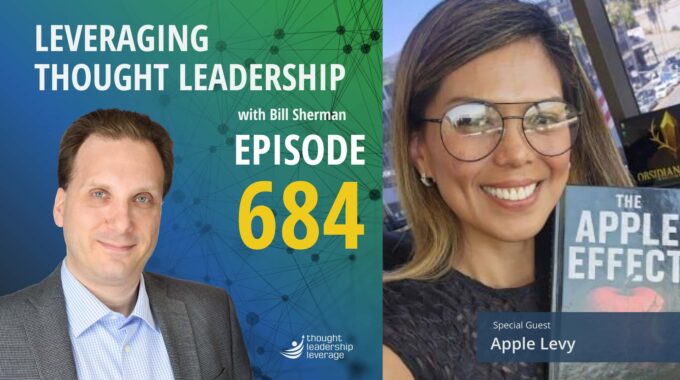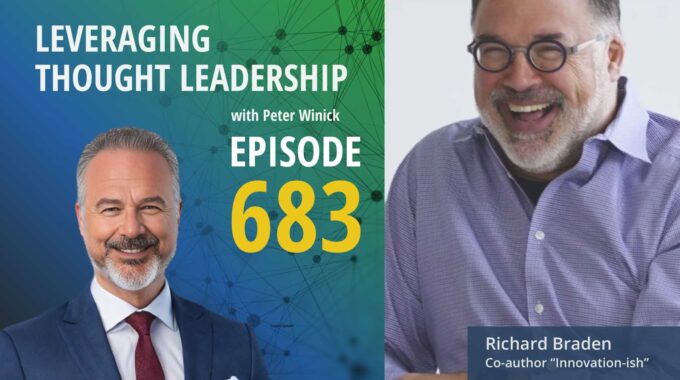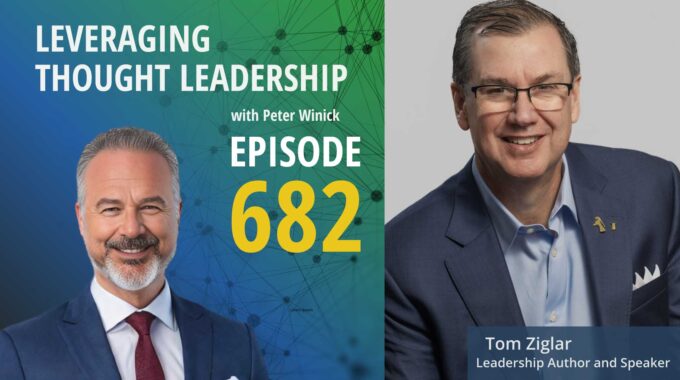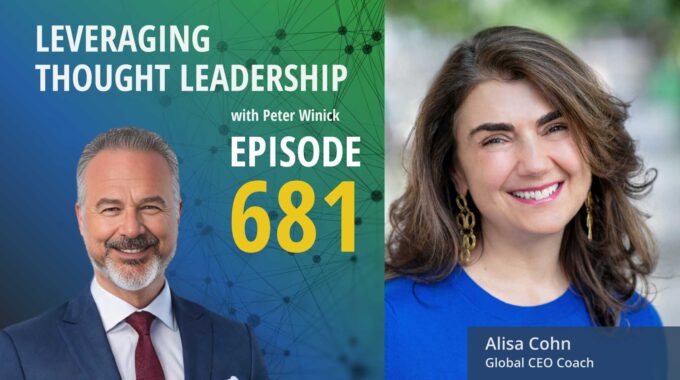A field-tested framework for leaders who want better margins, cleaner operations, and a stronger culture…
Crafting Bespoke Thought Leadership | Howard Brown
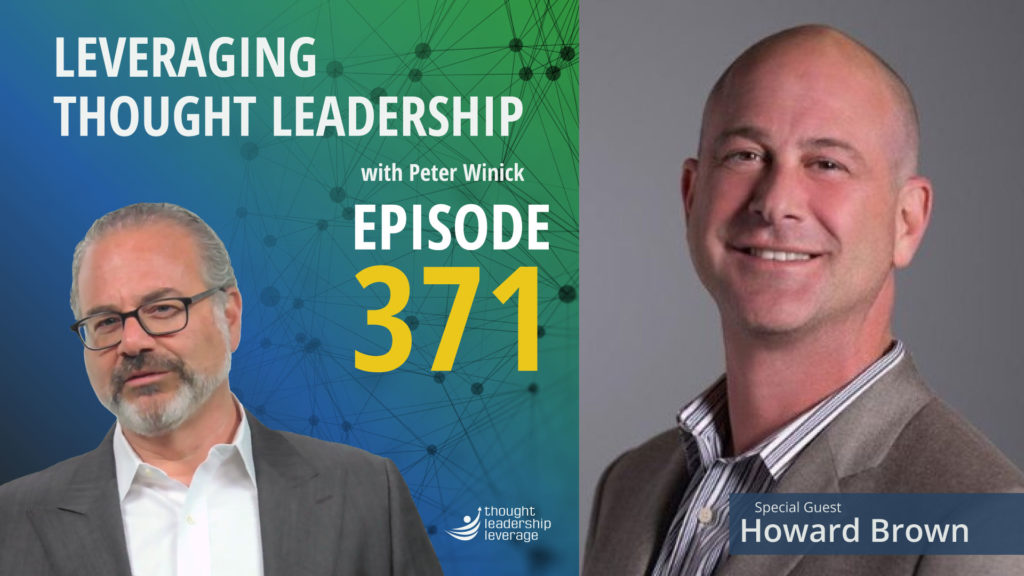
Personalizing thought leadership for a narrow audience.
An interview with Howard Brown about the psychology of thought leadership, and how CEOs can best use thought leadership.
With a seemingly endless supply of options for any service or product, how do you make sure that yours rises above the noise? Better yet, as a buyer, how can you know which product or service is right for you?
Today we are joined by Howard Brown, the Founder and CEO of ringDNA (now known as Revenue.io), an AI-powered platform that helps clients unlock revenue growth. Howard has also been listed as one of the 100 Most Intriguing Entrepreneurs by Goldman Sachs, and a top CEO according to Comparably. With a strong background in clinical psychology, Howard’s position on thought leadership comes from a deep understanding of the way people work and think.
Howard shares his insights on thought leadership, how using TL internally can help your employees find strength, realize opportunities, and improve, so that they can deliver their best performance.
As a CEO, Howard shares great advice for those who are just starting on the leadership journey. He delves into the how’s and why’s of using thought leadership internally and externally at your company, and what it means to be a CEO who understands thought leadership’s purpose. In addition, we discuss “finding your superpower,” and why being hyper-personalized with your message will better connect with a specific audience. Make sure they know you are speaking directly to them, and taking into account their individual needs!
If you want to use thought leadership to tell a story and deliver value for your entire organization, this is a great episode for you.
Three Key Takeaways:
- As digital conversations replace more and more face-to-face ones, we need Thought Leadership to build those connections. Listen to your audience, pay attention to their needs, and create a sense of insight and vision.
- When starting down the path of thought leadership, start by doing your research! It’s important to truly understand what thought leadership is… and what it is not.
- It can be tempting to create thought leadership for “everyone” because it’s easy. Narrowcasting is much harder, but the ROI is greater – especially if you crack the code and reach the right audience for your insights.
If you need a strategy to bring your thought leadership to market, Thought Leadership Leverage can assist you! Contact us for more information. In addition, we can help you implement marketing, research, and sales. Let us help you so you can devote yourself to what you do best.
Transcript
Peter Winick And welcome, welcome, welcome, this is Peter Winick, I’m the founder and CEO at Thought Leadership Leverage, and you’re joining us on the podcast today, which is Leveraging Thought Leadership.
Peter Winick Today, my guest – this will be this will be fun – It’s Howard Brown. Howard is the founder and CEO of ringDNA, where he fosters an innovative, fast growing and collaborative culture. He’s a three time entrepreneur and former clinical psychologist, so that’s an interesting combination right there. Howard’s thought leadership on sales entrepreneurship A.I. has appeared on Bloomberg TV, Fox Business, Forbes, and Entrepreneur magazine. He’s a frequent speaker at conferences such as Dreamforce and AWS re:Invent, and he’s been listed as one of the 100 Most Intriguing Entrepreneurs of 2019 by Goldman Sachs and atop CEO, according to Comparatively. So without further ado, welcome aboard, Howard.
Howard Brown Peter, it’s so great to be here with you.
Peter Winick My pleasure. So I want to dive in because, you know, in the Venn diagram of my world and your world, it’s its thought leadership, right? So tell me a bit about – A, first, how are you defining it? And then what are you doing with it?
Howard Brown So look, I think – I think we’re all hungry for thought leadership. I think as consumers, as people who have, quite frankly in the more recent times have felt somewhat isolated, right? We don’t have the same level of human interaction as we used to have. We don’t have the same level of social connection and we’ve moved towards more and more digital. And because of that, I think people are looking for things that matter to them, things that help them and things that ultimately drives excitement, intrigue and vision. And so for us, thought leadership is really a core piece of what humans crave. They crave direction, they crave inspiration, they crave likeminded people. I think that tapping into people’s wants and needs and providing a level of connection is really core to everything we do, as you mentioned. I’m a clinical psychologist by background. I spent a lot of time really focusing on how people connect, what causes strain in that connection, how people tell the narrative of their own lives and where the breakdowns are.
Peter Winick Yeah, I was going to say so. That speaks to sort of this innate human need to connect and be intrigued and the curiosity and all that sort of stuff, which I get and I agree with you. Flip it to the other side and talk a bit as you know, Howard, the CEO. So you just had your sort of human therapy hat on. Not that CEOs are not human, but now put the CEO hat on top of that one and say, Well, so what right? What’s the benefit of thought leadership for a CEO in a space that’s crowded, standing out from the competition, being able to show prospects and clients who you guys are and what you’re about? How has that been part of the story for you?
Howard Brown Yeah. And it’s funny because I don’t believe that the two pieces are detached. I think actually, if we’re working towards helping people, employees, companies optimize performance, if we’re trying to provide a better customer experience, which ultimately leads to a better brand experience, that it requires us to think about our employees, that requires us to think about the experience that we’re giving our employees. And if they have tools and processes that don’t help them excel and help them grow, then it’s going to be really difficult for them to connect with our customer, right? So we’re everybody’s talking about sustaining –
Peter Winick So, stay there for a minute because most often when we’re talking about thought leadership from a business perspective, right, we tend to think more about external. This would be great for prospects. This would be great for clients, which would be great for whatever you just went down. A slightly different path, which I find really interesting is it shows internally. So the value of thought leadership internally helps us aligned to the mission, the vision that what are we doing? Why are we different whatever? So you’re getting that internal buy in and therefore I would imagine that’s going to emanate radiate whatever when your employees are touching prospective clients and such.
Howard Brown That’s right. And that’s and that’s what we do as a company, as a culture, and that’s what our product does. Our product really is about focusing people on those areas that they can optimize to deliver the best performance, right? Because at the end of the day, we’re not trying to automate people out of the equation. What we’re trying to do is figure out what they’re good at, where there’s opportunities for growth, challenge them and help them get better. And I think once you as an employee feel like you’re supporting feel like the tools that you’re given make use. Order make you more to help you exceed and excel at your job. All of that equates into delivering better experiences for your customers, which ultimately lead to better enterprise value for your company.
Peter Winick So speak now to other CEOs that are out there listening that have a good business. It’s growing, it’s vibrant that no obvious fires or anything along those lines. But they haven’t done that thought leadership thing yet, whatever that might mean. What should they be thinking? Where might they start? What should they avoid, right? So give them sort of from a CEO to CEO. Hey, here’s a thought leadership one on one. Here’s what to think about and what you consider and how to maybe go about integrating thought leadership into your business.
Howard Brown Well, look, Peter, I’m a I’m a huge fan. I’m now 39 podcasts in over the last month and a half, so I would start by listening to this podcast. Really, I think it’s really important to understand what thought leadership is and what it isn’t. And it varies, right? It definitely varies from CEO to CEO company, the company. What I believe is at the end of the day, a lot of the services and products that we are providing, quite frankly, are getting commoditized.
Peter Winick I’m actually not a lot. I would say. If we’re honest, everything is at risk of being commoditized. That’s right. That’s right, right? And I think that I just want to stay there because I think it’s a key point in that there’s certain things that are obviously businesses that are more at risk of being commoditized. But when you come at it from a technology standpoint, oh, we have our patents, oh, we have our that’s all we have or that at the end of the day, all technology is a tool to accomplish an objective and everything is at risk of being commoditized. Whether you’re an attorney, whether you, you know, things that we thought of that were protected or had a moat around them. Now some are at greater risk than others, and I am a huge believer that the most cost effective way to fight commoditization is through thought leadership.
Howard Brown I, I couldn’t agree with you more. That’s why I said listening to your podcast would certainly help those CEOs out there.
Peter Winick I also I just wanted you to say it again.
Howard Brown Yeah, no, I – I mean – I mean, give me that tee-ball, man, I’m not knocking it out of the – . Or you go really going back to the fact that businesses and products and services can be spun up so quickly in the SAS world, where compute power is, their storage is their, you know, building products and services is not easy, but it’s a hell of a lot easier than it used to be. Now the buyer is trying to figure out how to make their business or effective more efficient. How do they do? How do they buy? We can teach people how to professionally sell, but we don’t teach people how to professionally buy, right. People don’t necessarily understand how to buy. And with all of these different products that all seem to say the same thing. How do they stand out? How do they look different? How do I relate to whomever is selling me something, right? So if that product or that person speaks to me, they understand me, they understand my persona.
Peter Winick You should go back to the CEO, though, so go back to the CEO because I’m a CEO should be here. I’ve got my pen out and I’m trying to figure this out, right? And I’ve talked to my other CEO friends and one says, Go write a book and make yourself a rock star. Another says, Host the podcast and others to get senior leadership on your team out on podcasts and other says democratize it. Have twenty two people in the firm create thought leadership. What are the things like? How did bring down DNA start down the path of thought leadership?
Howard Brown Yeah, I think I’ve spent the last twenty five years in some way or another in thought leadership. I think the thought leadership is has evolved tremendous rapidly. And so to me, thought leadership is critical in telling a story. Thought leadership is critical in delivering that value. But to answer your question more directly, I think it very much depends on the state of your current company. What you currently what currently exists is thought leadership that’s in the sales department, in the marketing department, in the office of the CEO. It’s all over the place, right?
Peter Winick And it might not even be officially recognized as a thing, but Charlie over there writes an article for this trade magazine, and the CEO occasionally speaks like it’s this scattered about kind of thing that nobody really
Howard Brown owns, right? So a couple of years ago, we bought a podcast and brought on Andy Paul never thought leader in the sales space. Why does that matter?
Peter Winick Because at the end, a client of Thought Leadership Leverage for a long time and a client.
Howard Brown So, yeah, but Andy has an audience of people who listen to him daily, weekly, subscribe to his beliefs and understand that when they come to that podcast, they’re going to be presented value that directly correlates to them and their life, whether it’s Andy or myself or any other individuals within our organization trying to create value and deliver that value to our customers, to our prospects that ultimately will help differentiate us from any other commoditized service that exists out there in the marketplace. If you’re enjoying this episode of Leveraging Thought Leadership, please make sure to subscribe.
Peter Winick If you’d like to help spread the word about our podcast, please leave us a review and share it with your friends. We’re available on Apple Podcasts and on all major listening apps, as well as at Thought Leadership Leverage dot com forward slash podcasts.
Peter Winick A lot of other, so, stay there for one second, Howard. So I think because there’s a lot of key points that I want to just push on a little bit. So Andy’s awesome Andy has produced. I don’t even know how many thousands of podcast episodes by now and has developed an amazing brand in the sale space, right? So I know when I tune in to Andy, my headspace is I’m going to find some really good, insightful information relative to sales. I’m not going to hear about wine. I’m not going to hear about technology. I’m not going to hear about. I don’t know the war for talent, any, you know, he doesn’t jump on some of the bandwagon laser focus. So I think part of the challenge folks have with thought leadership is, Oh, there’s so many things I could say and shouldn’t say. It might say whatever you have to think of it like a radio station, right? If I have my classic rock station in my car and then I have my jazz station and I turn on the jazz station and there’s punk rock and there’s, you know, I turn on the classic station and it’s like heavy metal or something. I’m really confused and I think that because there’s so much coming at us so quickly. That level of consistency is absolutely mission critical.
Howard Brown You nailed it. By nature, we’re fairly tribal people, which means yes, they want what we want. We want likeminded people. We want to feel comfortable. We want to. We want to get what we expect. And I think marketing and sales has thought about broadcasting, right? Let’s send messages out. It’s a widest possible. It’s really about narrowcasting, right? It’s really about you seeing this movement towards a based marketing account based sales. It’s really understanding who you’re selling to, who you’re talking to and making sure that you deliver very specific value to that persona.
Peter Winick So I’m in violent agreement of what you said, and I think that part of the issue is it is somewhat lazy to be broadcasting and it’s harder to narrow cast, right? And to us when we work with our clients like we’ve got to get really tired of what are the avatars you can’t be all things to all people. Full stop. So who are we trying to reach? And it doesn’t mean that each organization has one avatar. You might have three to five forever, but what are the pain points of a sales leader versus an individual contributor? What are what are the pain points of somebody selling know? I don’t know. Product versus service is a high ticket complex sale with a long sales cycle versus something short. Whatever different pain points, right? And you can’t you can’t deliver a one size fits all message in this world. So I love the narrowcasting piece. It’s harder to do, but is the ROI is exponentially greater if you crack the code up
Howard Brown one hundred percent. Let’s go back to your question, which is I’m a CEO sitting here listening to this podcast where I start, where do you start? Is What is your superpower? What is what is so unique about you? What value can you present that you can bring that makes you a thought leader? Because if you don’t have something unique and you’re just yet odd, then probably you shouldn’t be a thought leader. You should be a generalist and you should find someone else within the organization that can be that thought leader.
Peter Winick And that’s OK, too. And then, you know, some people don’t have the passion for whatever. I would say I love the superpower idea, but I would layer on top of the super power. Let’s start with, you know, most CEOs, I would say almost all can clearly identify their strategy, their goals, their objectives, etc. What is that place? And sometimes thought leadership starts? Is this skunkworks? I don’t know. It’s sort of a theme. Whatever it needs to, it can’t be the tail that wags the dog. If our business strategy is grow through client penetration versus growth through that new client acquisition, great and our thought leadership needs to support that. If not, it’s just noise, right? So how do we look at our business objectives and goals then say, Ah, what is the thought leadership that can support this? And it’s not that the answer to every business objective is more thought. Leadership is just not certain, but thought leadership. It could be if you, as a CEO, we’re selling to other CEOs. The modality by which you deliver that thought leadership could be a series of very intimate dinners could be one on one. You might you might be in five different cities with 10 different CEOs talking. You’re talking points, literally not, you know, verbatim, but that is a deployment of thought leadership that’s different where you know, somebody brings in Howard and some industry conference in front of a thousand individual contributor thought so different. Same day the thought leadership no pun intended right, but different audience, different tuning, different anecdotes to bring it to life, etc. Yeah.
Howard Brown Yeah, I mean, hyper personalization is something we’ve been talking about. Like if your thought leadership is hyper personalized, then you’re probably doing a pretty good job. You’ve identified your audience and you’re delivering expected value every time they log into your podcast. Every time they read your white paper, when they open your book, you have hyper personalize your experience, your expertise and you found your audience.
Peter Winick So I want to just expand on that because I think that’s a critical piece. So I think about a continuum of feedback that you can get on a piece of thought leadership on one end of the continuum. While Howard, it sounds like you wrote that article just for me. You were the fly on the wall in the meeting I had a week ago Tuesday, and that piece that you did was Holy cow, like you. You know you’re in my head. Holy cow, man. The other side of it is back in the day when we were flying, I’m sitting in the airline and I, you know, the airline magazine, it’s like seven restaurants to eat in Austin, Texas, that that’s bad content. But that was written for anybody that happened to sit in seat 13 d that day. Right, exactly. And it doesn’t have that sense of, you know, we all want to feel special. We all want, you know, we sport right? And I think getting that challenge showed that everybody feels as if because you don’t want to literally go through the effort of writing custom content for 800 different clients. But how do you get it so that the feeling is is bespoke as possible for everyone that experiences it? And I think that that’s really where the challenges.
Howard Brown Yeah, and that’s where the excitement is. And for me, I think of myself as a revenue scientist, right? We’re trying to I love that. Yeah. And what works for what persona in every possible situation, right? So the idea of situational awareness, that’s what makes an all-star baseball player is they understand the situational awareness, they understand what that situation is and what they need to get done. And so whether they’re at bat or they’re the star second baseman that knows that they have to throw the ball to second base before first that split second, that moment is what creates those experts. It’s why they succeed, and they win. And what we’re trying to do is study that we’re trying to understand all the different situations so that you can optimize for that performance, right? Everybody talks about Adam or account-based marketing or their personalization. You have to understand a lot about people. You have to understand what makes them tick, what they value, what emotionally connects with them, what has worked and what hasn’t. You brought up food and the restaurant guide in the back of the magazine? I met with a Michigan chef. One time, he said, Do you know what? The greatest feedback? The greatest thing that I can get strictly black and white? Did the person finish everything on the plate? It’s Brian. Right? Here’s a Michelin chef saying I can tell if they liked it based on whether or not they eat it right.
Peter Winick How much of the scraps are going in the garbage? Probably not. Right, right, right.
Howard Brown If we can make other decisions that simple, right, like figuring out what works and what doesn’t and prescribing that, that’s what’s exciting for me. So figuring out what works for people, whether it’s thought, leadership or sales or anything else, you need to communicate to your audience?
Peter Winick Yeah, I love it. So this has been phenomenal. How would I appreciate you sharing your insights and your opinions? And it seems like we’re in violent agreement on lots of things with might be somewhat less interesting to listeners, but I think there’s a lot to be left to be learned from your journey as well. So thank you for sharing with us today.
Howard Brown Thanks, Peter.
Peter Winick To learn more about Thought Leadership Leverage, please visit our website at ThoughtLeadershipLeverage.com to reach me directly. Feel free to email me at Peter at ThoughtLeadershipLeverage.com and please subscribe to Leveraging Thought Leadership on iTunes or your favorite podcast app to get your weekly episode automatically.



